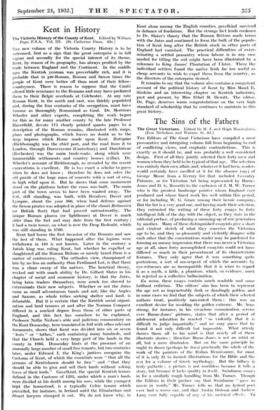Kent in History
The Victoria History of the County of Kent. Edited by William Page, F.S.A. Vol. HI. (St. Catherine Press. 63s.)
Tin new volume of the Victoria County History is to be welcomed, first as a sign that the great enterprise is in full vigour and secondly for the special interest of its theme. Kent, by reason of its geography, has always profited by the trade between England and the Continent. .In the middle ages the Kentish yeoman. was proverbially rich, and it is probable that in pre-Roman, Roman and Saxon times the people of Kent were better off than most of their fellow- countrymen. There is reason to suppose that the Cantu offered little resistance to the Romans and may have preferred them to their Belgic overlords at Colchester. At any rate Roman Kent, in the north and east, was thickly populated and, during the four centuries of the occupation, must have become as thoroughly Romanized as Gaul, Dr. Mortimer Wheeler and other experts, completing, the work begun for this as for many another county by the late Professor Haverfield, devote 175 closely printed quarto pages to a description of the Roman remains, illustrated with maps, plans and photographs, which leaves no doubt as to the deep _ impress which Rome made upon Kent. Rutupiae (Richborough) was the chief port, and the road from it to London, through Durovernum (Canterbury) and Durobrivae (Rochester) was the main- trade-route, along which were innumerable settlements and country houses (villae). Dr. Wheeler's account of Richborough, as revealed by the recent excavations, is excellent. He is too exact a scholar to guess when he does not know ; therefore he does not solve the old puzzle of the huge mass of concrete with a sort of cross in high relief upon it. But he shows that some monument stood on the platform before the cross was built. The main part of the town seems to have been washed away. The fort, still standing, was built, with Reculver, Dover and Lympne, about the year 300, when land defence against the Saxon pirates was adopted in place of the classis Brilannica (or British fleet) that had proved untrustworthy. The unique Roman pharos (or lighthouse) at Dover is much older than the fort and may date from the first century ; it had a twin tower, on what is now the Drop Redoubt, which was still standing in 1700.
Kent had borne the first invasion of the Romans and saw the last of them. What happened after the legions were withdrawn in 410 is not known. Later in the century a Jutish king was ruling Kent, but whether he expelled or slaughtered all the Roman Britons or merely taxed them is a matter of controversy. The orthodox view, championed of late by no less an authority than Ferdinand Lot, is that there was a clean sweep of the natives. The heretical theory, worked -out with much ability by Dr. Gilbert Slater in his chapter of social and economic history, is that the Jutes, being keen traders themselves, were much too shrewd to exterminate their new subjects. Whether or not the Jutes came as small adventurous bands and not, like the Angles and Saxons, as whole tribes seeking shelter and land, is debatable. But it is certain that the Kentish social organi- zation and land tenures at and after the Norman Conquest differed in a marked degree from those of other parts of England, and this fact . has somehow to be explained. Professor Nellie Neilson's able and judicious commentary on the Kent Domesday, here translated in full with other relevant documents, shows that Kent was divided into six or seven " lests " or " lathes," each containing many hundreds, and that the Church held a very large part of the lands in the county in 1086. Domesday hints at the presence of an unusually large number of small free tenants, but two centuries later, under Edward I, the King's justices recognize the Customs. of Kent, of which the essentials were " that all the persons of Kentishmen should be free " and " that they should be able to give and sell their lands without asking leave of their lords." Gavelkind, the special Kentish tenure defined in the Customs of 1203, under which a man's lands were divided at his death among his sons, while the youngest kept the homestead, is a typically Celtic tenure which prevailed, for instance, in Ireland until the Elizabethan and Stuart lawyers stamped it out. We do not know why, in
Kent alone among the English counties, gavelkind survived in defiance of feudalism. But the strange fact lends credence to Dr. Slater's theory that the Roman Britons made terms with the Jutes and continued to form the bulk of the popula- tion of Kent long after the British stock in other parts of England had vanished. The practical difficulties of exter- minating a settled peasantry whose labour is in any case needed for tilling the soil might have been illustrated by a reference to King James' Plantation of Ulster. There the individual settlers found the native Irish far too useful as cheap servants to wish to expel them from the country, as the directors of the enterprise desired.
It remains to say that the volume also contains a competent account of the political history of Kent by Miss Maud E. Simkins and an interesting chapter on Kentish industries, past and present, by Miss Ethel M. Hewitt. The editor, Dr. Page, deserves warm congratulations on the very high standard of scholarship that he continues to maintain in this great history.






























 Previous page
Previous page